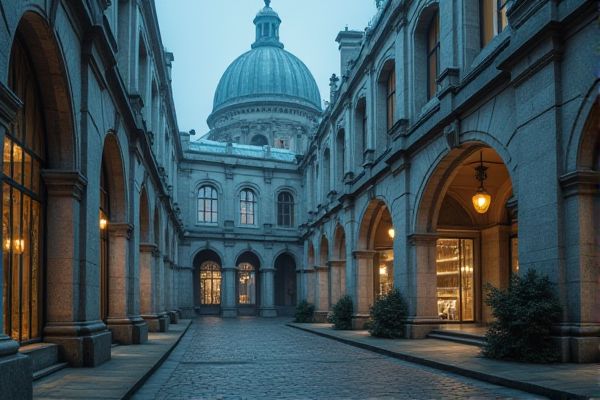
AI technology plays a significant role in historical preservation by enabling the digitization of artifacts and documents, making them accessible to a wider audience. Machine learning models can analyze and restore deteriorated images of historical sites, enhancing their visual fidelity for future generations. Natural language processing is employed to categorize and archive vast amounts of historical texts, ensuring that critical information is preserved and easily retrievable. Predictive analytics help in assessing potential risks to heritage sites, allowing for timely interventions to safeguard cultural resources.
AI usage in historical preservation
Digital Archiving
AI can enhance historical preservation by enabling more efficient digital archiving processes. With advanced algorithms, institutions like the British Library can automate the digitization of rare manuscripts, increasing accessibility for researchers. These tools also assist in analyzing large datasets to uncover patterns in historical documents, potentially providing new insights. The integration of AI in this field offers the possibility of preserving cultural heritage in more interactive and engaging ways.
3D Reconstructions
AI can enhance historical preservation through accurate 3D reconstructions of artifacts and sites. For example, institutions like the British Museum utilize AI to create detailed models of ancient objects, allowing for better analysis and accessibility. This technology provides a chance to engage the public in history through virtual experiences. Furthermore, it holds potential for preserving items that may be at risk due to environmental factors or human impact.
Artifact Analysis
AI can significantly enhance historical preservation by facilitating artifact analysis through pattern recognition and classification. For instance, the use of machine learning algorithms can assist museums in categorizing thousands of artifacts, making it easier to manage collections. This technology may also uncover hidden details in artifacts, allowing for a deeper understanding of historical contexts. As a result, institutions like the Smithsonian could experience improved engagement and educational opportunities for their audiences.
Predictive Modeling
AI can significantly enhance historical preservation by using predictive modeling techniques to forecast potential risks to artifacts and structures. Institutions like the Getty Conservation Institute implement machine learning algorithms to analyze environmental factors and assist in conservation strategies. This allows for targeted preservation efforts, reducing damage and extending the lifespan of cultural heritage. The possibility of saving priceless historical artifacts increases when predictive models inform proactive measures.
Virtual Reality Exhibits
AI has the potential to enhance historical preservation by analyzing vast amounts of archival data to identify patterns and connections. For example, virtual reality exhibits at institutions like the Smithsonian can create immersive experiences, allowing visitors to engage with history more interactively. This technology can provide new opportunities for education and outreach, increasing public interest in historical sites. The integration of AI could also streamline the restoration processes, thereby enhancing the preservation of cultural heritage.
Data Restoration
AI technology can enhance historical preservation by enabling more precise data restoration techniques. For example, historical documents can be scanned and analyzed using AI algorithms to recover lost text or images, making them accessible for research. This method allows institutions like the National Archives to maintain and share their valuable collections more effectively. The chances of improving the quality and availability of preserved materials are significantly increased through AI applications.
Automated Transcription
AI can enhance historical preservation by automating transcription processes, making it easier to convert handwritten documents into digitized formats. This technology increases accessibility for researchers and the public, allowing for greater engagement with historical materials. For example, the use of AI in transcribing documents from the National Archives can significantly reduce the time required to make these resources available. With improved accuracy and efficiency, AI offers a chance to expand the scope of historical research and preservation efforts.
Image Recognition
AI can enhance historical preservation through image recognition by automating the process of cataloging and restoring artifacts. For example, institutions like the Smithsonian utilize advanced algorithms to identify and classify images of historical items efficiently. This technology offers the potential for more accurate records and easier accessibility to resources for researchers and enthusiasts. The chance of discovering previously unrecognized details in artifacts increases with AI's capacity to analyze large datasets.
Heritage Site Monitoring
AI technologies can enhance historical preservation by analyzing structural integrity and predicting potential deterioration at heritage sites. For instance, machine learning algorithms can monitor environmental changes that affect monuments, allowing for timely intervention. This proactive approach may significantly reduce restoration costs and extend the lifespan of valuable cultural assets. Institutions like UNESCO are increasingly exploring these innovations to support conservation efforts globally.
Cultural Narrative Reconstruction
AI can enhance historical preservation by analyzing large datasets of artifacts and documents to identify patterns and connections. For instance, institutions like the Smithsonian are using AI to reconstruct cultural narratives from fragmented historical records, which may reveal previously overlooked aspects of history. This technology offers the possibility of making historical research more comprehensive and accessible. The potential to visualize historical events through immersive simulations may also engage a wider audience in understanding cultural heritage.
 techknowy.com
techknowy.com